Case Study: Medication Error Incident in a Sydney Hospital Ward
VerifiedAdded on 2020/03/04
|7
|1520
|244
Case Study
AI Summary
This case study presents an analysis of a medication error that occurred in the coronary care unit of a Sydney hospital. A newly qualified graduate nurse, working in the unit, administered the wrong medication to a patient, leading to a critical incident. The assignment details the incident, explores potential causes of the error, such as lack of experience, high-pressure work environments, and inadequate pharmaceutical knowledge. It also discusses the nurse's immediate actions, including informing the doctors, documenting the incident, and informing the patient. Furthermore, the study emphasizes the importance of intervention measures to minimize the effects of medication errors, including proper documentation, communication with the healthcare team and the patient, and the nurse's role in taking responsibility and seeking further training. The case study also highlights the need for increased awareness among nurses and improvements in nursing training practices to prevent similar incidents in the future.
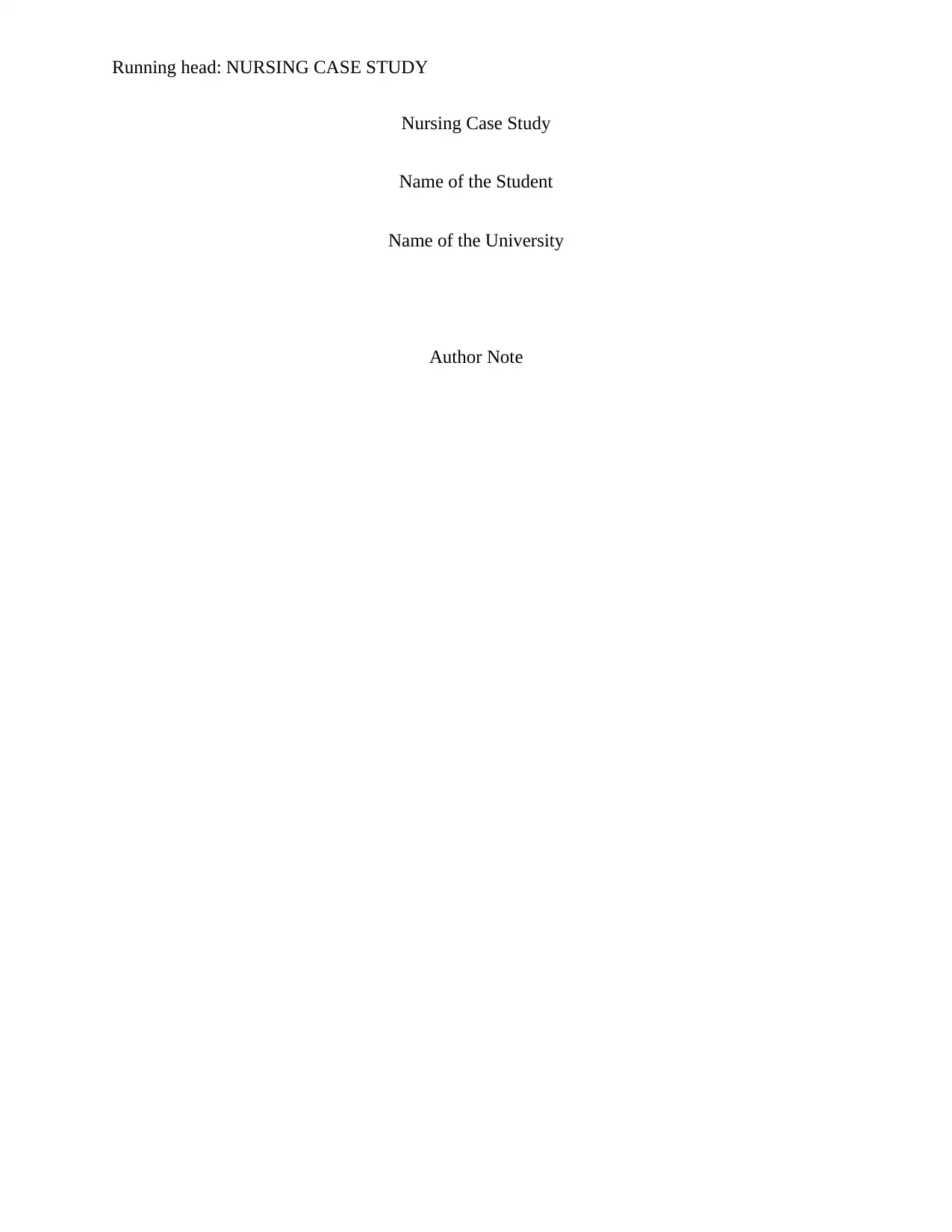
Running head: NURSING CASE STUDY
Nursing Case Study
Name of the Student
Name of the University
Author Note
Nursing Case Study
Name of the Student
Name of the University
Author Note
Paraphrase This Document
Need a fresh take? Get an instant paraphrase of this document with our AI Paraphraser
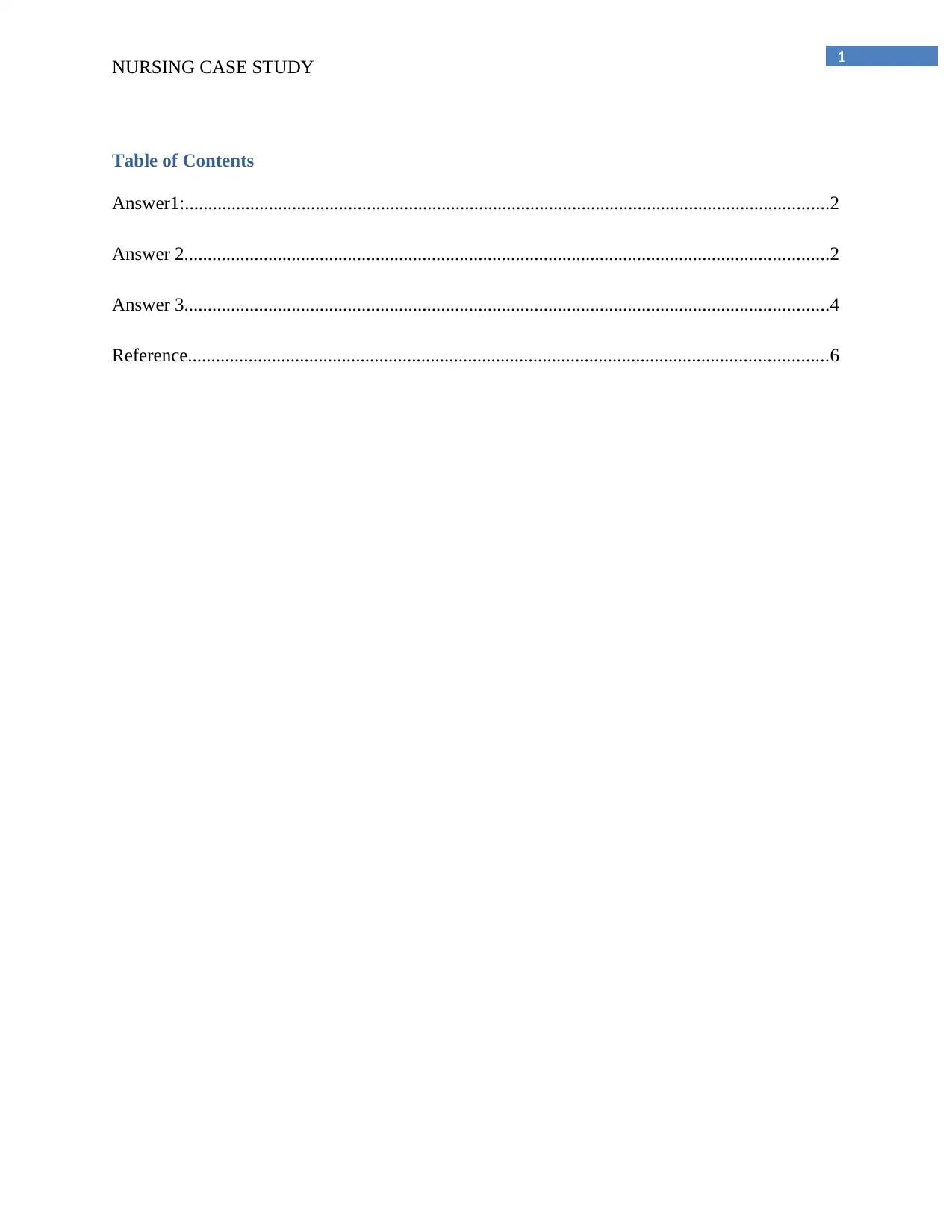
1
NURSING CASE STUDY
Table of Contents
Answer1:..........................................................................................................................................2
Answer 2..........................................................................................................................................2
Answer 3..........................................................................................................................................4
Reference.........................................................................................................................................6
NURSING CASE STUDY
Table of Contents
Answer1:..........................................................................................................................................2
Answer 2..........................................................................................................................................2
Answer 3..........................................................................................................................................4
Reference.........................................................................................................................................6
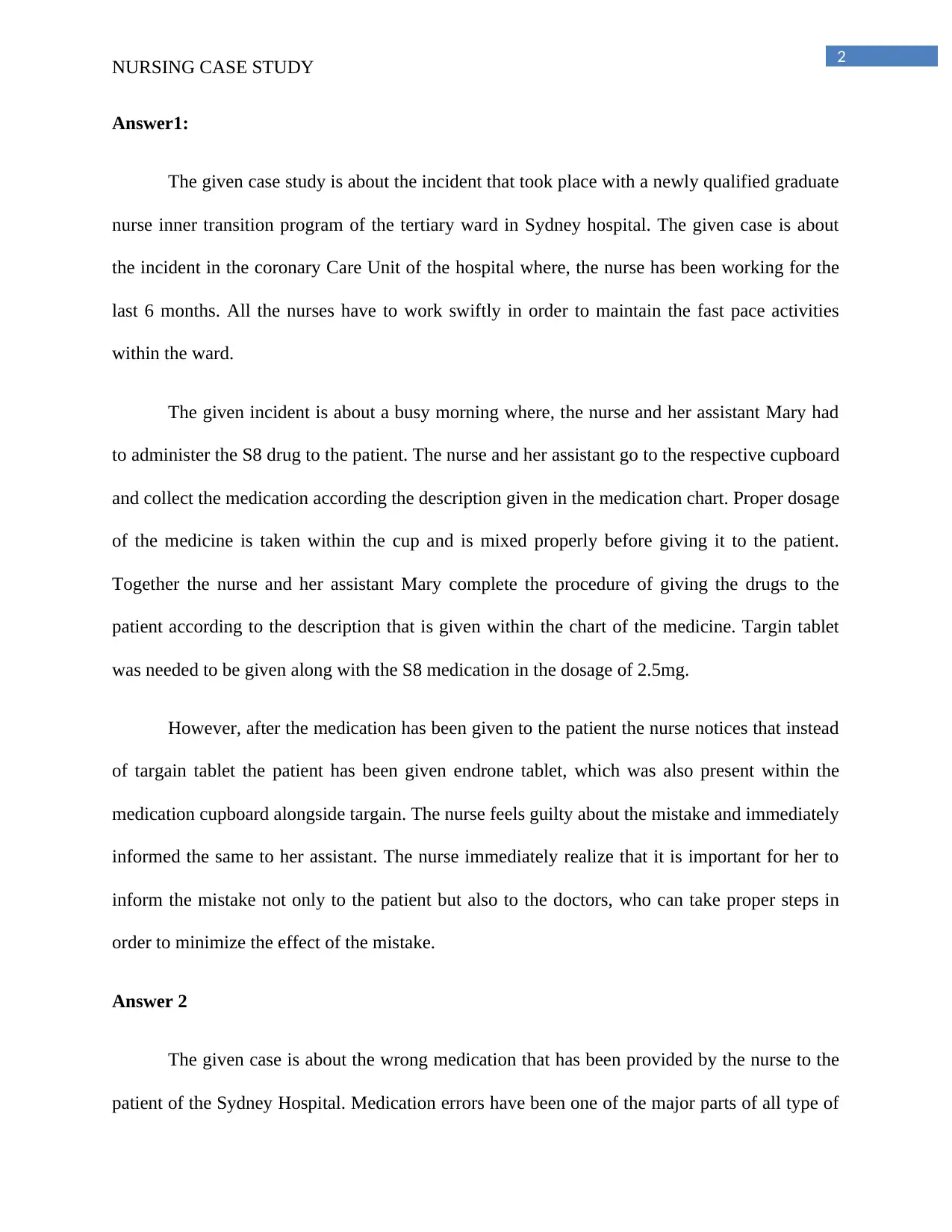
2
NURSING CASE STUDY
Answer1:
The given case study is about the incident that took place with a newly qualified graduate
nurse inner transition program of the tertiary ward in Sydney hospital. The given case is about
the incident in the coronary Care Unit of the hospital where, the nurse has been working for the
last 6 months. All the nurses have to work swiftly in order to maintain the fast pace activities
within the ward.
The given incident is about a busy morning where, the nurse and her assistant Mary had
to administer the S8 drug to the patient. The nurse and her assistant go to the respective cupboard
and collect the medication according the description given in the medication chart. Proper dosage
of the medicine is taken within the cup and is mixed properly before giving it to the patient.
Together the nurse and her assistant Mary complete the procedure of giving the drugs to the
patient according to the description that is given within the chart of the medicine. Targin tablet
was needed to be given along with the S8 medication in the dosage of 2.5mg.
However, after the medication has been given to the patient the nurse notices that instead
of targain tablet the patient has been given endrone tablet, which was also present within the
medication cupboard alongside targain. The nurse feels guilty about the mistake and immediately
informed the same to her assistant. The nurse immediately realize that it is important for her to
inform the mistake not only to the patient but also to the doctors, who can take proper steps in
order to minimize the effect of the mistake.
Answer 2
The given case is about the wrong medication that has been provided by the nurse to the
patient of the Sydney Hospital. Medication errors have been one of the major parts of all type of
NURSING CASE STUDY
Answer1:
The given case study is about the incident that took place with a newly qualified graduate
nurse inner transition program of the tertiary ward in Sydney hospital. The given case is about
the incident in the coronary Care Unit of the hospital where, the nurse has been working for the
last 6 months. All the nurses have to work swiftly in order to maintain the fast pace activities
within the ward.
The given incident is about a busy morning where, the nurse and her assistant Mary had
to administer the S8 drug to the patient. The nurse and her assistant go to the respective cupboard
and collect the medication according the description given in the medication chart. Proper dosage
of the medicine is taken within the cup and is mixed properly before giving it to the patient.
Together the nurse and her assistant Mary complete the procedure of giving the drugs to the
patient according to the description that is given within the chart of the medicine. Targin tablet
was needed to be given along with the S8 medication in the dosage of 2.5mg.
However, after the medication has been given to the patient the nurse notices that instead
of targain tablet the patient has been given endrone tablet, which was also present within the
medication cupboard alongside targain. The nurse feels guilty about the mistake and immediately
informed the same to her assistant. The nurse immediately realize that it is important for her to
inform the mistake not only to the patient but also to the doctors, who can take proper steps in
order to minimize the effect of the mistake.
Answer 2
The given case is about the wrong medication that has been provided by the nurse to the
patient of the Sydney Hospital. Medication errors have been one of the major parts of all type of
⊘ This is a preview!⊘
Do you want full access?
Subscribe today to unlock all pages.

Trusted by 1+ million students worldwide
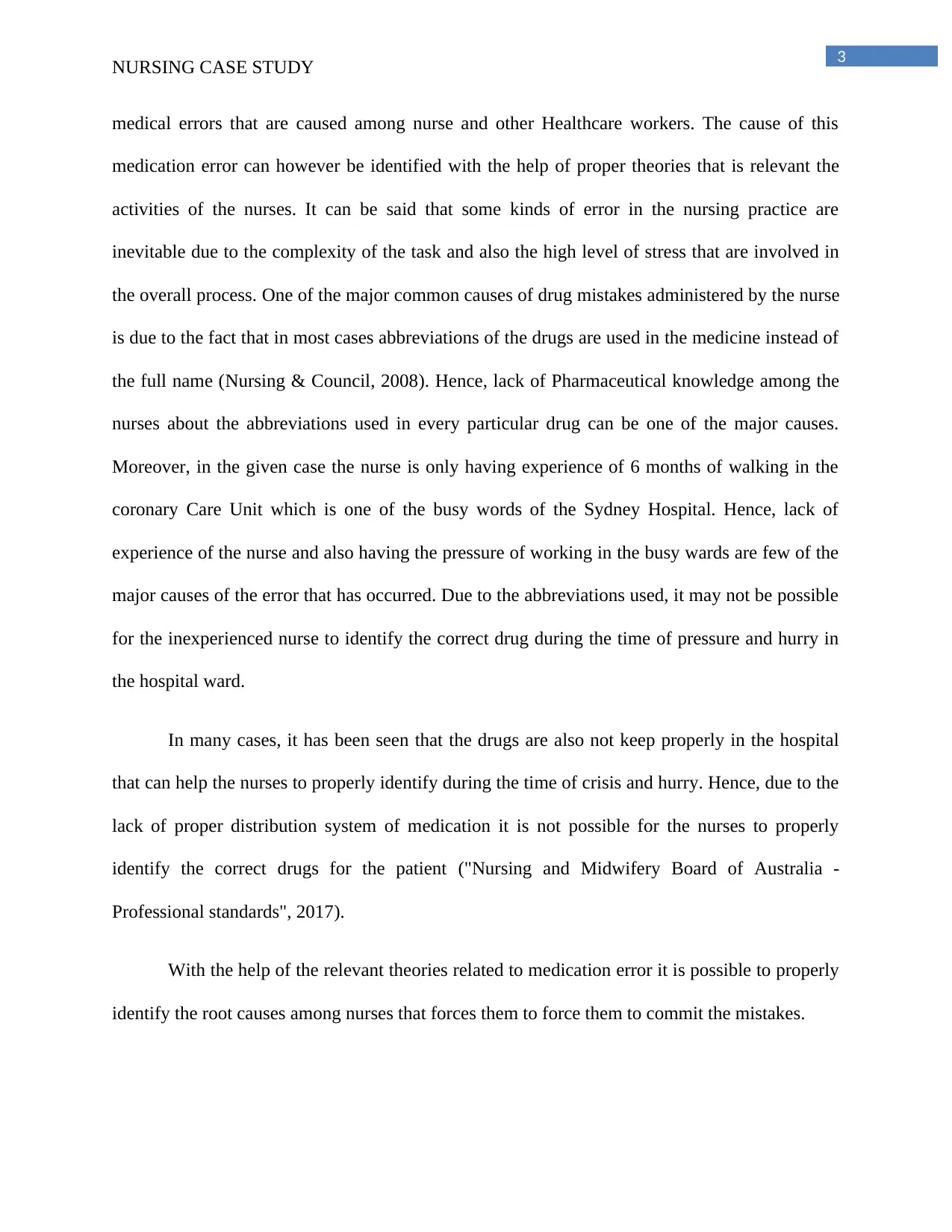
3
NURSING CASE STUDY
medical errors that are caused among nurse and other Healthcare workers. The cause of this
medication error can however be identified with the help of proper theories that is relevant the
activities of the nurses. It can be said that some kinds of error in the nursing practice are
inevitable due to the complexity of the task and also the high level of stress that are involved in
the overall process. One of the major common causes of drug mistakes administered by the nurse
is due to the fact that in most cases abbreviations of the drugs are used in the medicine instead of
the full name (Nursing & Council, 2008). Hence, lack of Pharmaceutical knowledge among the
nurses about the abbreviations used in every particular drug can be one of the major causes.
Moreover, in the given case the nurse is only having experience of 6 months of walking in the
coronary Care Unit which is one of the busy words of the Sydney Hospital. Hence, lack of
experience of the nurse and also having the pressure of working in the busy wards are few of the
major causes of the error that has occurred. Due to the abbreviations used, it may not be possible
for the inexperienced nurse to identify the correct drug during the time of pressure and hurry in
the hospital ward.
In many cases, it has been seen that the drugs are also not keep properly in the hospital
that can help the nurses to properly identify during the time of crisis and hurry. Hence, due to the
lack of proper distribution system of medication it is not possible for the nurses to properly
identify the correct drugs for the patient ("Nursing and Midwifery Board of Australia -
Professional standards", 2017).
With the help of the relevant theories related to medication error it is possible to properly
identify the root causes among nurses that forces them to force them to commit the mistakes.
NURSING CASE STUDY
medical errors that are caused among nurse and other Healthcare workers. The cause of this
medication error can however be identified with the help of proper theories that is relevant the
activities of the nurses. It can be said that some kinds of error in the nursing practice are
inevitable due to the complexity of the task and also the high level of stress that are involved in
the overall process. One of the major common causes of drug mistakes administered by the nurse
is due to the fact that in most cases abbreviations of the drugs are used in the medicine instead of
the full name (Nursing & Council, 2008). Hence, lack of Pharmaceutical knowledge among the
nurses about the abbreviations used in every particular drug can be one of the major causes.
Moreover, in the given case the nurse is only having experience of 6 months of walking in the
coronary Care Unit which is one of the busy words of the Sydney Hospital. Hence, lack of
experience of the nurse and also having the pressure of working in the busy wards are few of the
major causes of the error that has occurred. Due to the abbreviations used, it may not be possible
for the inexperienced nurse to identify the correct drug during the time of pressure and hurry in
the hospital ward.
In many cases, it has been seen that the drugs are also not keep properly in the hospital
that can help the nurses to properly identify during the time of crisis and hurry. Hence, due to the
lack of proper distribution system of medication it is not possible for the nurses to properly
identify the correct drugs for the patient ("Nursing and Midwifery Board of Australia -
Professional standards", 2017).
With the help of the relevant theories related to medication error it is possible to properly
identify the root causes among nurses that forces them to force them to commit the mistakes.
Paraphrase This Document
Need a fresh take? Get an instant paraphrase of this document with our AI Paraphraser
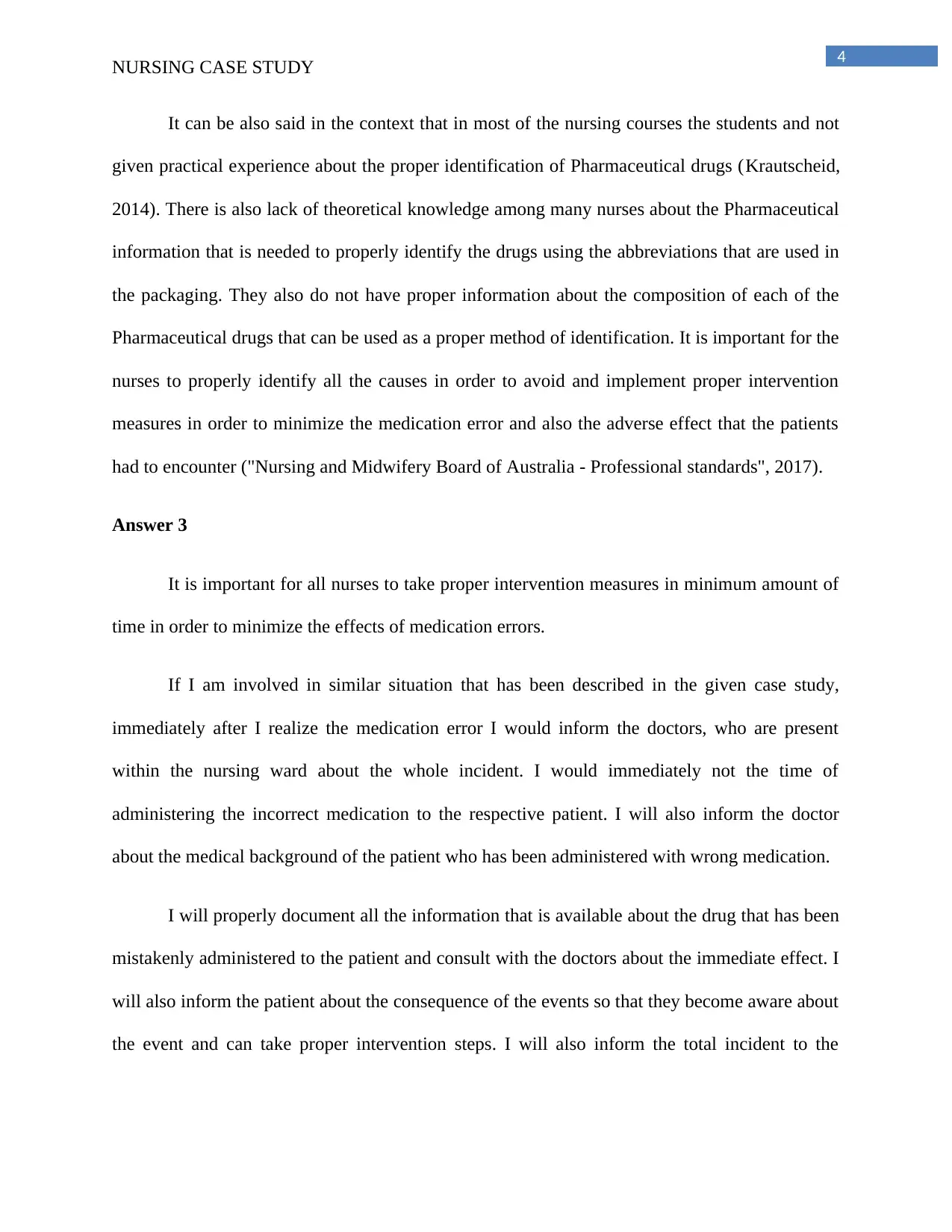
4
NURSING CASE STUDY
It can be also said in the context that in most of the nursing courses the students and not
given practical experience about the proper identification of Pharmaceutical drugs (Krautscheid,
2014). There is also lack of theoretical knowledge among many nurses about the Pharmaceutical
information that is needed to properly identify the drugs using the abbreviations that are used in
the packaging. They also do not have proper information about the composition of each of the
Pharmaceutical drugs that can be used as a proper method of identification. It is important for the
nurses to properly identify all the causes in order to avoid and implement proper intervention
measures in order to minimize the medication error and also the adverse effect that the patients
had to encounter ("Nursing and Midwifery Board of Australia - Professional standards", 2017).
Answer 3
It is important for all nurses to take proper intervention measures in minimum amount of
time in order to minimize the effects of medication errors.
If I am involved in similar situation that has been described in the given case study,
immediately after I realize the medication error I would inform the doctors, who are present
within the nursing ward about the whole incident. I would immediately not the time of
administering the incorrect medication to the respective patient. I will also inform the doctor
about the medical background of the patient who has been administered with wrong medication.
I will properly document all the information that is available about the drug that has been
mistakenly administered to the patient and consult with the doctors about the immediate effect. I
will also inform the patient about the consequence of the events so that they become aware about
the event and can take proper intervention steps. I will also inform the total incident to the
NURSING CASE STUDY
It can be also said in the context that in most of the nursing courses the students and not
given practical experience about the proper identification of Pharmaceutical drugs (Krautscheid,
2014). There is also lack of theoretical knowledge among many nurses about the Pharmaceutical
information that is needed to properly identify the drugs using the abbreviations that are used in
the packaging. They also do not have proper information about the composition of each of the
Pharmaceutical drugs that can be used as a proper method of identification. It is important for the
nurses to properly identify all the causes in order to avoid and implement proper intervention
measures in order to minimize the medication error and also the adverse effect that the patients
had to encounter ("Nursing and Midwifery Board of Australia - Professional standards", 2017).
Answer 3
It is important for all nurses to take proper intervention measures in minimum amount of
time in order to minimize the effects of medication errors.
If I am involved in similar situation that has been described in the given case study,
immediately after I realize the medication error I would inform the doctors, who are present
within the nursing ward about the whole incident. I would immediately not the time of
administering the incorrect medication to the respective patient. I will also inform the doctor
about the medical background of the patient who has been administered with wrong medication.
I will properly document all the information that is available about the drug that has been
mistakenly administered to the patient and consult with the doctors about the immediate effect. I
will also inform the patient about the consequence of the events so that they become aware about
the event and can take proper intervention steps. I will also inform the total incident to the

5
NURSING CASE STUDY
hospital supervisor. In case there is any clinical retardation among the patient, I will take proper
note of the incident.
As one of the registered nurse of the hospital, I will take full responsibility of the mistake
that has occurred and also ensure that I take proper training in order to improve upon my skills
related to pharmaceuticals knowledge. One of the important roles of all the nurses in the context
is to respond properly according to the signs and symptoms that are displayed by the patient after
administration of the incorrect medication (Scanlon et al., 2016). It may be normal for the patient
to react abnormally after they are informed about the medication errors. It is my duty as a nurse
to fully assure the patient and their family about the immediate actions that are taken by the
doctors in order to minimize the adverse effects of this error. It is the duty of the nurses to deal
with all types of adverse effects and causes of deteriorating condition of the patient.
It will be also my moral duty to properly inform all the nurses within the hospital about
the consequence of the medical errors. This will help to increase the level of awareness among
all other nurses, which will help them to be more cautious while administering drugs to the
patient and thereby avoid similar circumstances in the future event. I will share my experience in
detail and also about the incidents that are involved with case and have forced me to commit the
mistakes. In the light of the events, it is also my duty to raise the level of awareness among the
other nurses that will not allow them to fall in such similar incidents in the future. I can also
suggest to the hospital administration about the changes in the nursing training practices that can
be incorporated in order to avoid similar incidents in the future cases of the hospital.
NURSING CASE STUDY
hospital supervisor. In case there is any clinical retardation among the patient, I will take proper
note of the incident.
As one of the registered nurse of the hospital, I will take full responsibility of the mistake
that has occurred and also ensure that I take proper training in order to improve upon my skills
related to pharmaceuticals knowledge. One of the important roles of all the nurses in the context
is to respond properly according to the signs and symptoms that are displayed by the patient after
administration of the incorrect medication (Scanlon et al., 2016). It may be normal for the patient
to react abnormally after they are informed about the medication errors. It is my duty as a nurse
to fully assure the patient and their family about the immediate actions that are taken by the
doctors in order to minimize the adverse effects of this error. It is the duty of the nurses to deal
with all types of adverse effects and causes of deteriorating condition of the patient.
It will be also my moral duty to properly inform all the nurses within the hospital about
the consequence of the medical errors. This will help to increase the level of awareness among
all other nurses, which will help them to be more cautious while administering drugs to the
patient and thereby avoid similar circumstances in the future event. I will share my experience in
detail and also about the incidents that are involved with case and have forced me to commit the
mistakes. In the light of the events, it is also my duty to raise the level of awareness among the
other nurses that will not allow them to fall in such similar incidents in the future. I can also
suggest to the hospital administration about the changes in the nursing training practices that can
be incorporated in order to avoid similar incidents in the future cases of the hospital.
⊘ This is a preview!⊘
Do you want full access?
Subscribe today to unlock all pages.

Trusted by 1+ million students worldwide
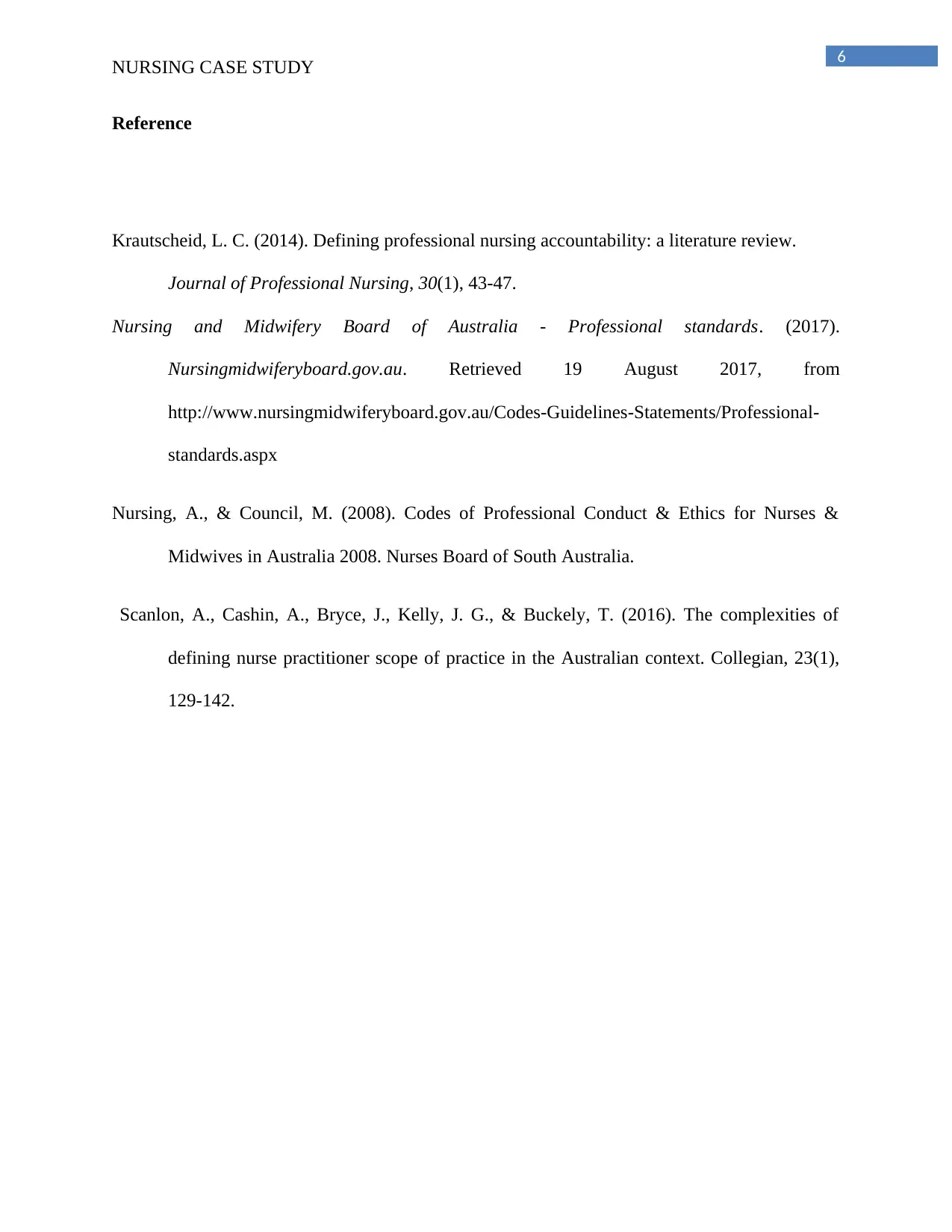
6
NURSING CASE STUDY
Reference
Krautscheid, L. C. (2014). Defining professional nursing accountability: a literature review.
Journal of Professional Nursing, 30(1), 43-47.
Nursing and Midwifery Board of Australia - Professional standards. (2017).
Nursingmidwiferyboard.gov.au. Retrieved 19 August 2017, from
http://www.nursingmidwiferyboard.gov.au/Codes-Guidelines-Statements/Professional-
standards.aspx
Nursing, A., & Council, M. (2008). Codes of Professional Conduct & Ethics for Nurses &
Midwives in Australia 2008. Nurses Board of South Australia.
Scanlon, A., Cashin, A., Bryce, J., Kelly, J. G., & Buckely, T. (2016). The complexities of
defining nurse practitioner scope of practice in the Australian context. Collegian, 23(1),
129-142.
NURSING CASE STUDY
Reference
Krautscheid, L. C. (2014). Defining professional nursing accountability: a literature review.
Journal of Professional Nursing, 30(1), 43-47.
Nursing and Midwifery Board of Australia - Professional standards. (2017).
Nursingmidwiferyboard.gov.au. Retrieved 19 August 2017, from
http://www.nursingmidwiferyboard.gov.au/Codes-Guidelines-Statements/Professional-
standards.aspx
Nursing, A., & Council, M. (2008). Codes of Professional Conduct & Ethics for Nurses &
Midwives in Australia 2008. Nurses Board of South Australia.
Scanlon, A., Cashin, A., Bryce, J., Kelly, J. G., & Buckely, T. (2016). The complexities of
defining nurse practitioner scope of practice in the Australian context. Collegian, 23(1),
129-142.
1 out of 7
Related Documents
Your All-in-One AI-Powered Toolkit for Academic Success.
+13062052269
info@desklib.com
Available 24*7 on WhatsApp / Email
![[object Object]](/_next/static/media/star-bottom.7253800d.svg)
Unlock your academic potential
Copyright © 2020–2025 A2Z Services. All Rights Reserved. Developed and managed by ZUCOL.





